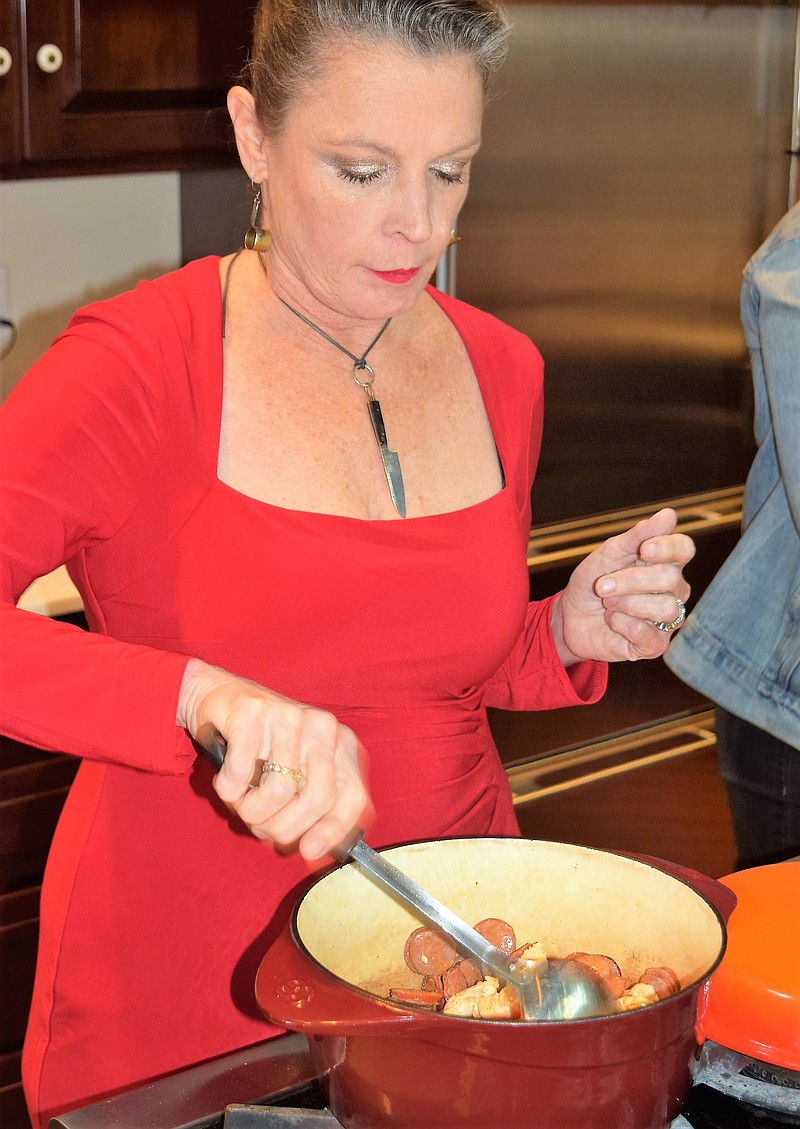Many cities around the world lay claim to certain foods. There's Chicago pizza, Boston beans and, in New Orleans, it's all about jambalaya.
"It's iconic to New Orleans," says Poppy Tooker, cookbook author, radio host of NPR's "Louisiana Eats" and a native of the Crescent City.
Tooker recently led a class of dedicated foodies in the art of making her hometown favorite in the factory kitchen at Zatarain's, a company founded in 1889 and firmly ingrained in the food culture of New Orleans.
As she sautés chunks of chicken and slices of andouille sausage, making sure each chunk and slice is browning nicely, she explains the roots of the word "jambalaya." While the dish itself is a fusion of several cultures that've left their footprint in the foodways of the area, the word is fused from three languages: "jambon" (French for "ham"); "a la" (Acadian slang for "a little of this and some of that"); and "ya" (African for "rice").
She continues stirring the pot, adding onions, peppers and celery, a mixture commonly known as the "holy trinity" but one she refers to as "Creole mirepoix." As she stirs, she discusses the connection between the people of the area and their jambalaya.
In the southern reaches of Louisiana, Tooker says, jambalaya is much darker in color. It's usually cooked in a big, heavy cast-iron pot over an open fire and that creates what Cajuns call "graton" - that brown crunchy stuff that you can scrape off the bottom of the pot. These people also use "green" sausage, similar to chorizo.
Areas north of the city cook jambalaya the way their German ancestors did when they settled in the area, using heavily smoked meats. And some use tomatoes.
"Tomatoes in jambalaya is a polarizing topic to come out of a Louisiana kitchen," Tooker says.
The dish is on the menu in many restaurants around town, but New Orleanians rarely order it when dining out, she notes.
"It's something we all make at home for parties. But if I do order it out, I'll get it at Bon Ton Cafe. Their crawfish jambalaya is the best in town. I've been tempted to tell them I'll write their cookbook just so I can get their recipe."
Jambalaya is one of the most versatile of all Cajun and Creole dishes, accepting any number of proteins from sausage to chicken, oysters, shrimp and crab. Or keep it simple and create a meatless vegetarian version. You might even want to create a jambalaya bar for your next party.
Dudley Passman, director of food service at Zatarain's, suggests preparing a pot of vegetarian jambalaya then serving it alongside bowls of different meats and vegetables such as grilled eggplant, squash and mushrooms, and let guests create their own.
The key to any jambalaya is the browning of ingredients, getting a good brown edge on the meats and seasonings, Tooker says.
"That's what separates the men from the boys," she says.
"And use parboiled rice," Passman advises. "It will make your jambalaya idiot-proof."
Poppy Tooker's Jambalaya
1 tablespoon vegetable oil
1 pound boneless, skinless chicken breasts, cut into 1-inch cubes
1 pound andouille sausage, cut into 1/4-inch slices
1 medium yellow onion, chopped
1 medium green bell pepper, chopped
1 rib celery, chopped
1 tablespoon minced fresh garlic
1 medium tomato, chopped
2 teaspoons Zatarain's Creole seasoning
1 teaspoon cayenne pepper
1 cup Zatarain's extra-long grain, parboiled rice
1 3/4 cups chicken stock
Heat oil in large heavy skillet on medium-high heat. Add chicken and sausage; cook and stir 5 minutes. Remove from skillet.
Add onion, bell pepper, celery and garlic; cook and stir on medium heat until onion is softened. Stir in tomato, Creole seasoning and cayenne pepper. Return chicken and sausage to skillet.
Add rice and stock; bring to boil. Reduce heat to low; cover and cook 25 minutes or until rice is tender, stirring occasionally. Makes 8 servings.
If you'd like to taste for yourself, the New Orleans Wine and Food Experience happens May 25-28, and tickets are on sale now. The cost includes wine, food, shows and more. For a complete listing of events and prices, log onto www.nowfe.com.
Contact Anne Braly at abraly@timesfreepress.com.

